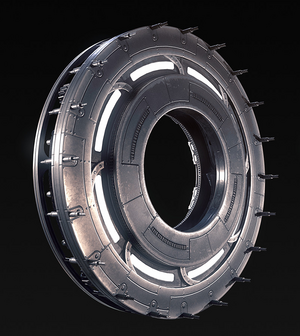
The Hermes Gate is the first generation of artificial wormhole technology based on the Stargates found in 2380. The Hermes Gate is designed for signal transmission /reception and requires significant power output to establish a wormhole, which limits the size of the gate.
- Dimensions
- 1.7 Meter Diameter Aperture / 2.9 Meter Diameter Edge to Edge
- Power Source
- 2 Impulse-Type Deuterium Fusion Reactors
SVR (Computer / Transceiver Power)
Control
The gate itself is controlled via a dedicated ECC built directly into the gate itself with an SVR as an emergency power source for the computer. Commands can be entered manually to the gate itself, transmitted via radio / subspace, or via hardline connection to an external console. The computer also manages the directionality of the wormhole and calculates subspace trajectories to void wormholes intersecting or passing through dangerous objects, such as a star or black hole.
Operation
Under normal operation the gate is active long enough to transmit and receive confirmation / receive and send confirmation. This usually takes a few seconds at most. The gate can handle standard and subspace radio transmissions and the wormhole can be configured to with tolerances for the transporter specification. Beaming through the gate is not within standard operating procedures, but the gate is capable of doing it.
Power
The gate draws its primary power supply from an external source, to safely establish and maintain a wormhole it must have maximum power output from a standard Impulse-Type Deuterium Fusion Reactor to establish / maintain a wormhole. Far less sophisticated / capable than the Stargate system, which even in Type 1 gates are able to use the massive power storage ability of the rare heavy element naquadah, which is not naturally occurring in known space.
Even with the full output of a fusion reactor, the gate requires to charge capacitors in order to establish a wormhole. With proper power output, the capacitor is maintained at full charge and can be recharged in mere seconds.
During standard operation the gate should be powered by at least 2 fusion reactors of sufficient power output to activate the gate. Solas Tempus regulations dictate this many dedicated reactors, minimum, for gate operation.
Emergency Operation
Like the Stargate design the gate is capable of establishing a wormhole with a target gate on significantly less power than it takes to maintain that wormhole. A wormhole, once established, can be maintained from either side of the connection. The built in SVR is capable of building a slow-power charge in the gate's capacitors which could be used to establish but not maintain a wormhole. In this mode of operation the gate would take a full 24 hours to charge the internal capacitors to full power.
Emergency Shutdown
During normal operation a gate is established, maintained, and shut down in sequence. The control system on both gates coordinates control through the wormhole, due to the massive amount of power involved an improper shut down can cause the gate itself to explode. This is because of the power discharge when shutting down an active wormhole, normally the gate uses a directed energy flow through the gate's capacitors and back into the power systems to dissipate that charge safely. In the event of emergency shut down when this is unavailable, the gate can suffer significant damage. This is why two fusion reactors are mandated, in the event of reactor failure, the gate can maintain the directed energy flow through the system and be shut down safely. If no power is available during emergency shut down, the gate will likely be significantly damaged and the resulting energy discharge could cause serious injury and death to anyone nearby. The power requirements for gate shut down require the directed energy flow be maintained by more power output than the collapsing wormhole sends into the system.